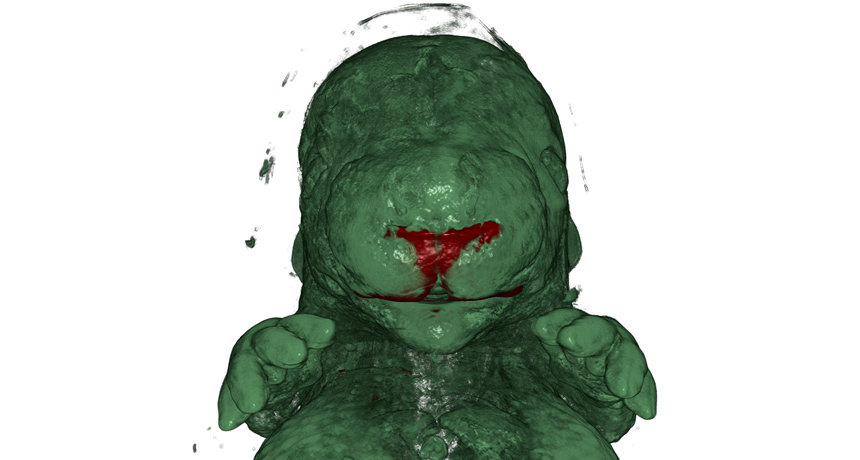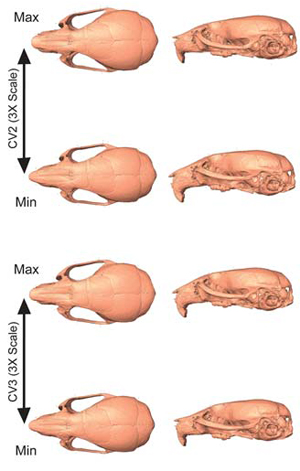What makes a face go round
How small tweaks in genes change the shape of a face

A 3-D image of an 11.5-day-old mouse embryo shows the activity pattern of a transcriptional enhancer (shown in red) during facial development.
Courtesy of H. Morrison/MRC Human Genetics Unit/Univ. of Edinburgh
- More than 2 years ago
Look closely in the mirror. What face shape do you see? A heart-shape? A triangle? A strong jaw or delicate cheekbones?
All of these features are determined by your genes. And they have incredibly important effects on how you are perceived (would Cyrano de Bergerac be half so famous without his nose?), and can have effects on your health as well. Cleft palate, for example, is the results of mutations in certain genes.
But a big change like a cleft palate is one thing. The tiny variations giving you that delicate pointed chin, however, are a little less extreme. And it turns out that there are many, many genes involved. These genes are transcriptional enhancers, short regions of DNA that can bind to proteins. The proteins are transcription factors, which control whether DNA is transcribed to RNA and then to protein. By binding to proteins, transcriptional enhancers can increase the activity of transcription factors, resulting in more transcribed DNA.
And these transcriptional enhancers don’t have to be right next to the DNA they are relevant to. Instead, they can act at a distance, sometimes hundreds of kilobases away from the gene. They can also act in different cell types at different times, meaning that transcriptional enhancers could produce a lot of the fine tuning that makes our faces the highly individualized things that they are.
The authors of a study in the Oct. 25 Science wanted to see what developmental enhancers might be acting to affect facial shape. To look at what small DNA sections might be involved, the researchers performed a ChIP-seq on developing mouse facial tissue. ChIP-seq precipitates chromatin and the DNA-associated proteins, to determine their binding sites. You can then sequence the DNA involved to see what you have. By using facial tissue from mice at an early fetal stage (day 11.5, when the face is developing), the scientists hoped that the transcriptional enhancers identified would be more likely to be associated with craniofacial development.
They ended up with more than 4,000 potential transcriptional enhancers, an eye-popping number. Many of them were located near genes that were already known for their role in craniofacial development. But how to know which ones are important in the development of facial shape? For this, the authors put in what is, to be honest, a MASSIVE amount of work. They expressed 205 of the transcriptional enhancers (most of which were selected to be near regions that are important in craniofacial development) in transgenic embryos, linked to “reporter” genes that would produce a glow when the transcriptional enhancers were active. This kind of work has become much easier in recent years, but it’s still highly repetitive and a lot of time. I salute the scientists for their devotion to LacZ activity.
Once the genes were expressed in mouse embryos, the scientists conducted detailed 3-D imaging to look at where exactly the transcriptional enhancers were showing up during development. Many of the transcriptional enhancers showed specific activity in the face, as in the image above, and were associated with important facial development genes, some of which were astonishingly far from the location of the enhancer.

But of course, seeing the activity of genes during development doesn’t necessarily mean you’ll be able to detect or predict the effects of them in the adult. To look at this, the scientists picked three of the transcriptional enhancers that produced the most consistent patterns during development and were also closely associated with different facial genes, and knocked them out in mouse embryos. They found that the transcriptional enhancers could have very subtle effects on the target genes. While one target gene, Snai2, showed a 3.9-fold decrease in activity when its transcriptional enhancer was absent. The large decrease shows how important the transcriptional enhancer is to the normal activity of this gene. Other transcriptional enhancers showed much smaller effects on their target genes.
The effects of the enhancers on gene activity might have looked subtle, but when groups of adult mice were examined for facial shape, the results were detectable, as seen in figure 7A. Deletion of the enhancer hsl431, for example, produced a longer snout and a wider “brow.” In contrast, deletion of hs746 resulted in a shorter snout, a wider back of the skull and a narrower palate. But none of the deletions produced major changes like a cleft palate. Instead, they produce subtle changes. A little shorter in the nose, a little wider in the brow.
It shows that the little changes provided by many, many transcriptional enhancers can help make the small tweaks that result in an individual facial shape. Of, course, this study was done in mice, but it’s very possible that these effects are present in humans (though hopefully none of them result in a long furry snout). The results could help scientists better understand what gives one person that chiseled jaw, and another that heavy brow. And the next time you look in the mirror, and see your cleft chin or your prominent cheekbones, send out many small thank yous to your many, many transcriptional enhancers.
Paper: C. Attanasio et al. Fine Tuning of Craniofacial Morphology by Distant-Acting Enhancers. Science. Vol. 342, October 25, 2013, p. 1241006. doi: 10.1126/science.1241006







